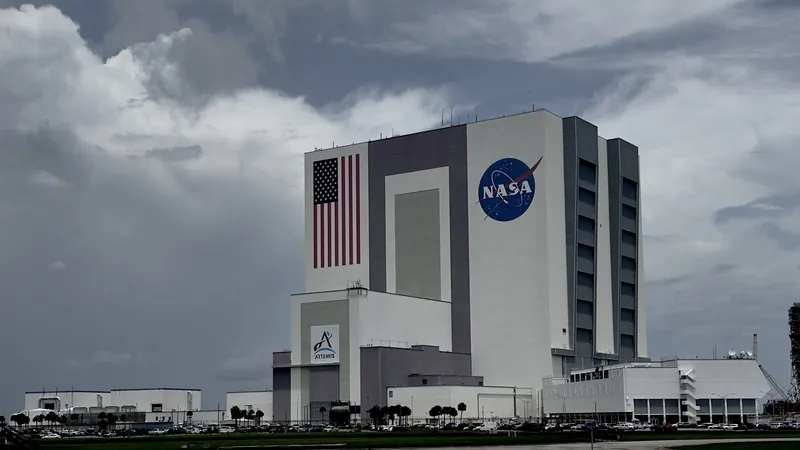
The Hidden Crisis in Astronomy: NASA's Missing Presence at Key Conferences
2025-06-26
Author: Ken Lee
A Stellar Absence at the Super Bowl of Astronomy
In Anchorage, Alaska, the atmosphere was charged at the American Astronomical Society's 246th meeting, famously dubbed the 'Super Bowl of Astronomy.' It's a unique gathering where the brightest minds in astronomy converge to ignite groundbreaking ideas about the cosmos. But this year, a significant force was conspicuously absent: NASA.
The Shockwaves of Withdrawal
NASA, along with the National Science Foundation (NSF), pulled out of the conference at the last moment, leaving a palpable void. These institutions are integral to the astronomy community, overseeing critical projects like the James Webb Space Telescope, the Hubble Space Telescope, and the LIGO gravitational wave detector. Their absence turned the usually buzzing conference into a muted affair.
Kevin Hardegree-Ullman, a scientist affiliated with the NASA Exoplanet Science Institute at Caltech, remarked, "Honestly, it's been a little devastating. NASA usually has a strong presence, and while some representatives did show up, it required excessive approval processes."
A Disturbing Trend in Scientific Collaboration
This year’s AAS meeting marked the first since significant changes were enacted by the Trump administration, including budget cuts to diversity and essential science funding. Attendees noticed that the meeting felt quieter than before, signaling the challenges facing the community as funding shifts threaten both research and future discoveries.
Why Did NASA and NSF Pull Out?
NASA’s departure is part of a larger trend. The agency also withdrew from other major conferences, citing a need to reallocate resources to prioritize human exploration of the Moon and Mars. A NASA spokesperson confirmed, "We are evaluating our spending and conference participation on a case-by-case basis," amidst proposed budget cuts that could decimate its science funding by nearly half.
Consequences of Compromised Funding
If the proposed FY 2026 budget goes through, it could shut down critical projects, including the Laser Interferometer Gravitational-Wave Observatory (LIGO) and the Daniel K. Inouye Solar Telescope. Moreover, the National Science Foundation may cut its Graduate Research Fellowship Program, jeopardizing the careers of promising young scientists.
Silent Voices at the Conference
The absence of NASA and NSF meant that two key "Town Halls," where scientists discuss vital updates, were off the agenda. With absent leadership figures, questions remained unanswered, casting an ominous shadow over future research possibilities. Scientists voiced their worries about losing funding and the long-term impact on their careers.
A Call to Action
As frustrations mounted, attendees expressed solidarity over the grim outlook facing their field. Many felt that current regulations stifled honest discussions about funding and the future of science. Hardegree-Ullman summed up the sentiment, stating, "We must advocate for our funding and communicate with our representatives to protect scientific integrity and future discoveries."
Looking Ahead: Hope Despite Hardships
As the astronomy community grapples with these challenges, the lingering hope among attendees is that unity and advocacy will pave the way for a resurgent spirit in science. Amidst uncertainty, scientists remain committed to fighting for the future of their research and the exploration of the universe. After all, the cosmos waits for no one.

 Brasil (PT)
Brasil (PT)
 Canada (EN)
Canada (EN)
 Chile (ES)
Chile (ES)
 Česko (CS)
Česko (CS)
 대한민국 (KO)
대한민국 (KO)
 España (ES)
España (ES)
 France (FR)
France (FR)
 Hong Kong (EN)
Hong Kong (EN)
 Italia (IT)
Italia (IT)
 日本 (JA)
日本 (JA)
 Magyarország (HU)
Magyarország (HU)
 Norge (NO)
Norge (NO)
 Polska (PL)
Polska (PL)
 Schweiz (DE)
Schweiz (DE)
 Singapore (EN)
Singapore (EN)
 Sverige (SV)
Sverige (SV)
 Suomi (FI)
Suomi (FI)
 Türkiye (TR)
Türkiye (TR)
 الإمارات العربية المتحدة (AR)
الإمارات العربية المتحدة (AR)